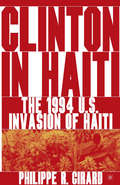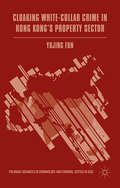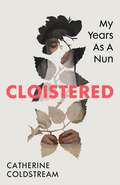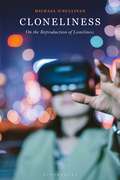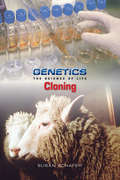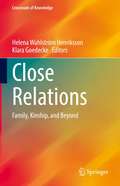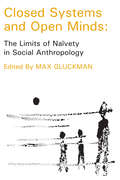- Table View
- List View
Clinton in Haiti: The 1994 US Invasion of Haiti
by P. GirardThe book focuses on Aristide's political career, emphasizing his strategizing, compromising and dealing with the Clinton administration. In his presentation of the conflict, Girard carefully balances Aristide's and Clinton's needs, and the demands and moral positions the leaders make against each other - the result is that each leader and his constituency comes to life, and their maneuverings and decisions become engaging and meaningful. While Girard focuses on the conflict itself and the foreign policy dynamics at play between Haiti and the US, he also paints a compelling picture of contemporary Haiti and delineates with great clarity the tensions which led to recent violence and the deposition of Aristide.
Clio/Anthropos: Exploring the Boundaries between History and Anthropology
by Eric Tagliacozzo, Andrew WillfordThe intersection between history and anthropology is more varied now than it has ever been—a look at the shelves of bookstores and libraries proves this. Historians have increasingly looked to the methodologies of anthropologists to explain inequalities of power, problems of voicelessness, and conceptions of social change from an inside perspective. And ethnologists have increasingly relied on longitudinal visions of their subjects, inquiries framed by the lens of history rather than purely structuralist, culturalist, or functionalist visions of behavior. The contributors have dealt with the problems and possibilities of the blurring of these boundaries in different and exciting ways. They provide further fodder for a cross-disciplinary experiment that is already well under way, describing peoples and their cultures in a world where boundaries are evermore fluid but where we all are alarmingly attached to the cataloguing and marking of national, ethnic, racial, and religious differences.
Clio in the Classroom: A Guide for Teaching U.S. Women's History
by Carol Berkin Margaret S. Crocco Barbara WinslowOver the last four decades, women's history has developed from a new and marginal approach to history to an established and flourishing area of the discipline taught in all history departments. Clio in the Classroom makes accessible the content, key themes and concepts, and pedagogical techniques of U.S. women's history for all secondary school and college teachers. Editors Carol Berkin, Margaret S. Crocco, and Barbara Winslow have brought together a diverse group of educators to provide information and tools for those who are constructing a new syllabus or revitalizing an existing one. The essays in this volume provide concise, up-to-date overviews of American women's history from colonial times to the present that include its ethnic, racial, and regional changes. They look at conceptual frameworks key to understanding women's history and American history, such as sexuality, citizenship, consumerism, and religion. And they offer concrete approaches for the classroom, including the use of oral history, visual resources, material culture, and group learning. The volume also features a guide to print and digital resources for further information. This is an invaluable guide for women and men preparing to incorporate the study of women into their classes, as well as for those seeking fresh perspectives for their teaching.
Clio in the Classroom: A Guide for Teaching U.S. Women's History
by Carol Berkin, Margaret S. Crocco And Barbara WinslowOver the last four decades, women's history has developed from a new and marginal approach to history to an established and flourishing area of the discipline taught in all history departments. Clio in the Classroom makes accessible the content, key themes and concepts, and pedagogical techniques of U.S. women's history for all secondary school and college teachers. Editors Carol Berkin, Margaret S. Crocco, and Barbara Winslow have brought together a diverse group of educators to provide information and tools for those who are constructing a new syllabus or revitalizing an existing one. The essays in this volume provide concise, up-to-date overviews of American women's history from colonial times to the present that include its ethnic, racial, and regional changes. They look at conceptual frameworks key to understanding women's history and American history, such as sexuality, citizenship, consumerism, and religion. And they offer concrete approaches for the classroom, including the use of oral history, visual resources, material culture, and group learning. The volume also features a guide to print and digital resources for further information. This is an invaluable guide for women and men preparing to incorporate the study of women into their classes, as well as for those seeking fresh perspectives for their teaching.
Clio's Foot Soldiers: Twentieth-Century U.S. Social Movements and Collective Memory (Public History in Historical Perspective)
by Lara Leigh KellandCollective memories are key to social movements. Activists draw on a shared history to build identity, create movement cohesion, and focus political purpose. But what happens when marginalized communities do not find their history in dominant narratives? How do they create a useable past to bind their political communities together and challenge their exclusion? In Clio's Foot Soldiers, Lara Leigh Kelland investigates these questions by examining 1960s and 1970s social movements comprised of historically marginalized peoples: Civil Rights, Black Power, Women's and Gay Liberation, and American Indian. These movements sought ownership over their narratives to create historical knowledge reflective of their particular experiences. To accomplish their goals, activists generated new forms of adult education, published movement newspapers, and pursued campus activism and speeches, public history efforts and community organizations. Through alternative means, marginalized communities developed their own historical discourses to mobilize members, define movement goals, and become culturally sovereign. In so doing, they provided a basis for achieving political liberation and changed the landscape of liberal cultural institutions.
Cloak of Charity: Studies in Eighteenth-Century Philanthropy (Routledge Revivals)
by Betsy RodgersFirst published in 1949, Cloak of Charity provides a short history of philanthropy in the eighteenth-century. The author asserts that the history of charity is the history of the changes which have occurred in the attitude of the rich towards the poor. The character of philanthropy changed considerably during the course of the eighteenth-century and it is this change that the book traces. This book will be of interest to students of history, sociology and religion.
Cloak of Charity: Studies in Eighteenth-Century Philanthropy (Routledge Revivals)
by Betsy RodgersFirst published in 1949, Cloak of Charity provides a short history of philanthropy in the eighteenth-century. The author asserts that the history of charity is the history of the changes which have occurred in the attitude of the rich towards the poor. The character of philanthropy changed considerably during the course of the eighteenth-century and it is this change that the book traces. This book will be of interest to students of history, sociology and religion.
Cloaking White-Collar Crime in Hong Kong's Property Sector (Palgrave Advances in Criminology and Criminal Justice in Asia)
by Yujing FunHong Kong's anti-corruption agency, ICAC, is hailed as among the world's best having almost completely purged systemic corruption within a decade of its inception. This book explains how Hong Kong maintains the myth of a clean city and examines the prevalence of white collar crime in the city's property sector.
The Clock Mirage: Our Myth of Measured Time
by Joseph MazurA tour of clocks throughout the centuries—from the sandglass to the telomere—to reveal the physical, biological, and social nature of time What is time? This question has fascinated philosophers, mathematicians, and scientists for thousands of years. Why does time seem to speed up with age? What is its connection with memory, anticipation, and sleep cycles? Award-winning author and mathematician Joseph Mazur provides an engaging exploration of how the understanding of time has evolved throughout human history and offers a compelling new vision, submitting that time lives within us. Our cells, he notes, have a temporal awareness, guided by environmental cues in sync with patterns of social interaction. Readers learn that, as a consequence of time’s personal nature, a forty-eight-hour journey on the Space Shuttle can feel shorter than a six-hour trip on the Soyuz capsule, that the Amondawa of the Amazon do not have ages, and that time speeds up with fever and slows down when we feel in danger. With a narrative punctuated by personal stories of time’s effects on truck drivers, Olympic racers, prisoners, and clockmakers, Mazur’s journey is filled with fascinating insights into how our technologies, our bodies, and our attitudes can change our perceptions. Ultimately, time reveals itself as something that rides on the rhythms of our minds. The Clock Mirage presents an innovative perspective that will force us to rethink our relationship with time, and how best to use it.
Cloistered: ‘[A] beautifully written memoir…evolves into a spiritual thriller’ Observer
by Catherine Coldstream'A profoundly moving memoir which gripped me' Mark HaddonDiscover Catherine Coldstream’s evocative account of life as a nun in the 1990s, and the dramatic events which led to her flight from the monastery.After the shock of her father’s death, twenty-four-year-old Catherine was left grieving and alone. A search for meaning led her to Roman Catholicism and the nuns of Akenside Priory.Here she found a tight-knit community of dedicated women and peace in an ancient way of life. But as she surrenders to her final vows, all is not as it seems behind the Priory’s closed doors. Power struggles erupt – with far-reaching consequences for those within.Catherine comes to realise that divine authority is mediated through flawed and all-too-human channels. She is faced with a dilemma: should she protect the serenity she has found, or speak out?A love song to a lost community and an honest account of her twelve years in the Order, Cloistered is also a cautionary tale about what can happen when good people cut themselves off from the wider world.‘Immersive, beautifully observed’ Katherine May'I admired [Cloistered] enormously' Sarah Perry‘An intense and often theatrical read’ Financial Times
Cloneliness: On the Reproduction of Loneliness
by Michael O'SullivanRecent posthuman philosophies, human-computer interface studies, and technology-inspired biopolitical discourses and practices are reinventing and reimagining loneliness in different communities. Cloneliness: The Reproduction of Loneliness takes a cross-cultural approach to loneliness by examining 20th-century artistic expressions and examinations of loneliness in the context of more recent global expressions grounded in social networks, virtual reality, the biopolitical commons, academic credentialization and such practices as Hikikomori. Newer forms of loneliness, pushed by the algorithms of biopolitical capitalism, result in what this books calls "cloneliness." Michael O'Sullivan plots the transformation in loneliness in literature and philosophy in readings that take us from Henry James and such classic works as Frank O'Connor's The Lonely Voice and Richard Yates's Eleven Kinds of Loneliness to more recent expressions in such writers as David Foster Wallace, Yiyun Li, and Sayaka Murata.Michael O'Sullivan argues that cloneliness as an institutional practice of reproduction in society nurtures, normalizes, and reproduces loneliness in order to create subjects who are more willing to accept ideologies of competition, “extreme individualism,” and the stresses of being "interconnected loners."
Cloneliness: On the Reproduction of Loneliness
by Michael O'SullivanRecent posthuman philosophies, human-computer interface studies, and technology-inspired biopolitical discourses and practices are reinventing and reimagining loneliness in different communities. Cloneliness: The Reproduction of Loneliness takes a cross-cultural approach to loneliness by examining 20th-century artistic expressions and examinations of loneliness in the context of more recent global expressions grounded in social networks, virtual reality, the biopolitical commons, academic credentialization and such practices as Hikikomori. Newer forms of loneliness, pushed by the algorithms of biopolitical capitalism, result in what this books calls "cloneliness." Michael O'Sullivan plots the transformation in loneliness in literature and philosophy in readings that take us from Henry James and such classic works as Frank O'Connor's The Lonely Voice and Richard Yates's Eleven Kinds of Loneliness to more recent expressions in such writers as David Foster Wallace, Yiyun Li, and Sayaka Murata.Michael O'Sullivan argues that cloneliness as an institutional practice of reproduction in society nurtures, normalizes, and reproduces loneliness in order to create subjects who are more willing to accept ideologies of competition, “extreme individualism,” and the stresses of being "interconnected loners."
Cloning: The Science Of Life
by Susan SchaferThis book provides in-depth explorations of genetic cloning, including the history of cloning and the types of artificial cloning for both plants and animals, with fascinating examples. It also explains the possibility of using the gene therapy to cure diseases.
Cloning
by Susan SchaferThis book provides in-depth explorations of genetic cloning, including the history of cloning and the types of artificial cloning for both plants and animals, with fascinating examples. It also explains the possibility of using the gene therapy to cure diseases.
Cloning Terror: The War of Images, 9/11 to the Present
by W. J. MitchellThe phrase “War on Terror” has quietly been retired from official usage, but it persists in the American psyche, and our understanding of it is hardly complete. Nor will it be, W. J. T Mitchell argues, without a grasp of the images that it spawned, and that spawned it. Exploring the role of verbal and visual images in the War on Terror, Mitchell finds a conflict whose shaky metaphoric and imaginary conception has created its own reality. At the same time, Mitchell locates in the concept of clones and cloning an anxiety about new forms of image-making that has amplified the political effects of the War on Terror. Cloning and terror, he argues, share an uncanny structural resemblance, shuttling back and forth between imaginary and real, metaphoric and literal manifestations. In Mitchell’s startling analysis, cloning terror emerges as the inevitable metaphor for the way in which the War on Terror has not only helped recruit more fighters to the jihadist cause but undermined the American constitution with “faith-based” foreign and domestic policies. Bringing together the hooded prisoners of Abu Ghraib with the cloned stormtroopers of the Star Wars saga, Mitchell draws attention to the figures of faceless anonymity that stalk the ever-shifting and unlocatable “fronts” of the War on Terror. A striking new investigation of the role of images from our foremost scholar of iconology, Cloning Terror will expand our understanding of the visual legacy of a new kind of war and reframe our understanding of contemporary biopower and biopolitics.
Cloning Terror: The War of Images, 9/11 to the Present
by W. J. MitchellThe phrase “War on Terror” has quietly been retired from official usage, but it persists in the American psyche, and our understanding of it is hardly complete. Nor will it be, W. J. T Mitchell argues, without a grasp of the images that it spawned, and that spawned it. Exploring the role of verbal and visual images in the War on Terror, Mitchell finds a conflict whose shaky metaphoric and imaginary conception has created its own reality. At the same time, Mitchell locates in the concept of clones and cloning an anxiety about new forms of image-making that has amplified the political effects of the War on Terror. Cloning and terror, he argues, share an uncanny structural resemblance, shuttling back and forth between imaginary and real, metaphoric and literal manifestations. In Mitchell’s startling analysis, cloning terror emerges as the inevitable metaphor for the way in which the War on Terror has not only helped recruit more fighters to the jihadist cause but undermined the American constitution with “faith-based” foreign and domestic policies. Bringing together the hooded prisoners of Abu Ghraib with the cloned stormtroopers of the Star Wars saga, Mitchell draws attention to the figures of faceless anonymity that stalk the ever-shifting and unlocatable “fronts” of the War on Terror. A striking new investigation of the role of images from our foremost scholar of iconology, Cloning Terror will expand our understanding of the visual legacy of a new kind of war and reframe our understanding of contemporary biopower and biopolitics.
Cloning Terror: The War of Images, 9/11 to the Present
by W. J. MitchellThe phrase “War on Terror” has quietly been retired from official usage, but it persists in the American psyche, and our understanding of it is hardly complete. Nor will it be, W. J. T Mitchell argues, without a grasp of the images that it spawned, and that spawned it. Exploring the role of verbal and visual images in the War on Terror, Mitchell finds a conflict whose shaky metaphoric and imaginary conception has created its own reality. At the same time, Mitchell locates in the concept of clones and cloning an anxiety about new forms of image-making that has amplified the political effects of the War on Terror. Cloning and terror, he argues, share an uncanny structural resemblance, shuttling back and forth between imaginary and real, metaphoric and literal manifestations. In Mitchell’s startling analysis, cloning terror emerges as the inevitable metaphor for the way in which the War on Terror has not only helped recruit more fighters to the jihadist cause but undermined the American constitution with “faith-based” foreign and domestic policies. Bringing together the hooded prisoners of Abu Ghraib with the cloned stormtroopers of the Star Wars saga, Mitchell draws attention to the figures of faceless anonymity that stalk the ever-shifting and unlocatable “fronts” of the War on Terror. A striking new investigation of the role of images from our foremost scholar of iconology, Cloning Terror will expand our understanding of the visual legacy of a new kind of war and reframe our understanding of contemporary biopower and biopolitics.
The Close-Knit Circle: American Knitters Today (American Subcultures)
by Kerry WillsKnitting has recently exploded in popularity. Professionals, punks, and feminists are embracing this ancient craft, an activity that was previously relegated to the realm of the traditional woman, the mother and homemaker. While knitting books featuring such hip projects as iPod cozies and yoga mat bags abound, few explore the subculture of knitting in any depth. Who are these people? Why knitting, why now? Wills takes the reader on a fascinating tour of this subculture, complete with lively anecdotes and revealing interviews. Those who are new to the craft will enjoy a fascinating introduction to the knitting community, while those who have been unable to put down their needles since knitting that first scarf will glean new ideas for their next blog session, online shopping spree, or knitting group get-together.Knitting has recently exploded in popularity. Professionals, punks, and feminists are embracing this ancient craft, an activity that was previously relegated to the realm of the traditional woman, the mother and homemaker. Books that cater to this new generation of knitters are flooding the market with patterns for such contemporary projects as iPod cozies, yoga mat bags, and laptop covers. The attitude of these publications is decidedly hip, featuring models sporting tattoos or piercings. Missing from the avalanche of knitting books, until now, is one that fully explores the subculture of knitting. Who are these people? Why knitting, why now?Intrepid journalist and avid knitter Kerry Wills set out to find out. She takes us on a fascinating tour through the history of knitting, exploring the lives of such women as the revolutionary Elizabeth Zimmermann, whose strong opinions and classic book, Knitting without Tears, popularized knitting in the 1970s, anticipating current trends. Wills visits knitting groups that meet at such places as a feminist vegetarian restaurant, churches, pubs, and senior centers. She describes political activists who knit tree cozies to protect the trees against developers, groups that knit afghans for Afghans, and knitters who make shawls for people with cancer. She also explores online knitting communities. Those who are new to the craft will come away feeling more connected to the history of knitting as well as to their place in today's universe of knitters, while those who have been unable to put down their needles since stitching that first scarf will glean new ideas for their next blog session, online shopping spree, or knitting group get-together.
Close Relations: Family, Kinship, and Beyond (Crossroads of Knowledge)
by Helena Wahlström Henriksson Klara GoedeckeThis book speaks to the meanings and values that inhere in close relations, focusing on ‘family’ and ‘kinship’ but also looking beyond these categories. Multifaceted, diverse and subject to constant debate, close relations are ubiquitous in human lives on embodied as well as symbolic levels. Closely related to processes of power, legibility and recognition, close relations are surrounded by boundaries that both constrain and enable their practical, symbolical and legal formation. Carefully contextualising close relations in relation to different national contexts, but also in relation to gender, sexuality, race, religion and dis/ability, the volume points to the importance of and variations in how close relations are lived, understood and negotiated.Grounded in a number of academic areas and disciplines, ranging from legal studies, sociology and social work to literary studies and ethnology, this volume also highlights the value of using inter- and multidisciplinary scholarly approaches in research about close relations.Chapter 11 is available open access under a Creative Commons Attribution 4.0 International License via link.springer.com.
Closed Systems and Open Minds: The Limits of Naivety in Social Anthropology
by Thomas SzaszSocial anthropology, defined operationally in terms of what social anthropologists have done in the last fifty years, is the study and comparison of tribal societies and of small fields of social life with emphasis on the role of custom. When a social anthropologist's research leads him into any field, which belongs to other disciplines, what line should he adopt? What use may he make of the results that other scholars have already achieved? Must he knowingly make naive assumptions concerning events, which they have regarded as complex? In each of the fascinating essays which in turn form the core of this book - V. W. Turner's on symbols in Ndembu ritual; F.G. Bailey's on disputes which occurred in two Orissa villages; A. L. Epstein's on urban communities in Africa; T. Lupton's and S. Cunnison's on the relationship between behaviour in three Manchester workshops and certain events which happened outside; and W. Watson's on social mobility and social class in a coalmining Scottish burgh-several social anthropologists attempt to answer these questions by discussing the problems of method that they have encountered in their own recent research; and in the searching discussion which sum up the results. To analyze one first has to circumscribe one's field, and then simplify within the area of circumscription. Both circumscription and simplification may involve procedures of absorbing, abridging, and making naive assumptions. The contributors draw attention to the attempt to distinguish between psychical facts (emotions, thoughts, etc.) and psychological, which we believe should apply only to statements within the science of psychology, and not to be used by the former. They similarly distinguish between social facts and sociological or social-anthropological statements. ""Psychological"" and ""sociological"" are so well established in common parlance as adjectives to categorize facts that attempts to specialize them as hopeless.
Closed Systems and Open Minds: The Limits of Naivety in Social Anthropology
by Thomas SzaszSocial anthropology, defined operationally in terms of what social anthropologists have done in the last fifty years, is the study and comparison of tribal societies and of small fields of social life with emphasis on the role of custom. When a social anthropologist's research leads him into any field, which belongs to other disciplines, what line should he adopt? What use may he make of the results that other scholars have already achieved? Must he knowingly make naive assumptions concerning events, which they have regarded as complex? In each of the fascinating essays which in turn form the core of this book - V. W. Turner's on symbols in Ndembu ritual; F.G. Bailey's on disputes which occurred in two Orissa villages; A. L. Epstein's on urban communities in Africa; T. Lupton's and S. Cunnison's on the relationship between behaviour in three Manchester workshops and certain events which happened outside; and W. Watson's on social mobility and social class in a coalmining Scottish burgh-several social anthropologists attempt to answer these questions by discussing the problems of method that they have encountered in their own recent research; and in the searching discussion which sum up the results. To analyze one first has to circumscribe one's field, and then simplify within the area of circumscription. Both circumscription and simplification may involve procedures of absorbing, abridging, and making naive assumptions. The contributors draw attention to the attempt to distinguish between psychical facts (emotions, thoughts, etc.) and psychological, which we believe should apply only to statements within the science of psychology, and not to be used by the former. They similarly distinguish between social facts and sociological or social-anthropological statements. ""Psychological"" and ""sociological"" are so well established in common parlance as adjectives to categorize facts that attempts to specialize them as hopeless.
Closely Watched Films (Routledge Revivals): The Czechoslovak Experience
by Antonín J. LiehmFirst published in 1974, this book collects interviews with leading Czechslovak filmmakers conducted mostly between 1967 and 1969. This was a period of immense upheaval beginning with the attack of the Czechoslovak establishment on the Union of Writers in 1967, continuing through the liberalisation of the Prague Spring in January 1968 and ended with the Soviet invasion in August and subsequent ‘Normalization’ process in April 1969. It records the testimony of several generations of filmmakers and their attempts to answer the questions about the purpose and meaning of film before and during this period. This book will be of interest to students of film and cultural history.
Closely Watched Films (Routledge Revivals): The Czechoslovak Experience
by Antonín J. LiehmFirst published in 1974, this book collects interviews with leading Czechslovak filmmakers conducted mostly between 1967 and 1969. This was a period of immense upheaval beginning with the attack of the Czechoslovak establishment on the Union of Writers in 1967, continuing through the liberalisation of the Prague Spring in January 1968 and ended with the Soviet invasion in August and subsequent ‘Normalization’ process in April 1969. It records the testimony of several generations of filmmakers and their attempts to answer the questions about the purpose and meaning of film before and during this period. This book will be of interest to students of film and cultural history.
Closer to Freedom: Enslaved Women and Everyday Resistance in the Plantation South (Gender and American Culture)
by Stephanie M. CampRecent scholarship on slavery has explored the lives of enslaved people beyond the watchful eye of their masters. Building on this work and the study of space, social relations, gender, and power in the Old South, Stephanie Camp examines the everyday containment and movement of enslaved men and, especially, enslaved women. In her investigation of the movement of bodies, objects, and information, Camp extends our recognition of slave resistance into new arenas and reveals an important and hidden culture of opposition.Camp discusses the multiple dimensions to acts of resistance that might otherwise appear to be little more than fits of temper. She brings new depth to our understanding of the lives of enslaved women, whose bodies and homes were inevitably political arenas. Through Camp's insight, truancy becomes an act of pursuing personal privacy. Illegal parties ("frolics") become an expression of bodily freedom. And bondwomen who acquired printed abolitionist materials and posted them on the walls of their slave cabins (even if they could not read them) become the subtle agitators who inspire more overt acts. The culture of opposition created by enslaved women's acts of everyday resistance helped foment and sustain the more visible resistance of men in their individual acts of running away and in the collective action of slave revolts. Ultimately, Camp argues, the Civil War years saw revolutionary change that had been in the making for decades.
The Closet: The Eighteenth-Century Architecture of Intimacy
by Danielle BobkerA literary and cultural history of the intimate space of the eighteenth-century closet—and how it fired the imaginations of Pepys, Sterne, Swift, and so many other writers Long before it was a hidden storage space or a metaphor for queer and trans shame, the closet was one of the most charged settings in English architecture. This private room provided seclusion for reading, writing, praying, dressing, and collecting—and for talking in select company. In their closets, kings and duchesses shared secrets with favorites, midwives and apothecaries dispensed remedies, and newly wealthy men and women expanded their social networks. In The Closet, Danielle Bobker presents a literary and cultural history of these sites of extrafamilial intimacy, revealing how, as they proliferated both in buildings and in books, closets also became powerful symbols of the unstable virtual intimacy of the first mass-medium of print.Focused on the connections between status-conscious—and often awkward—interpersonal dynamics and an increasingly inclusive social and media landscape, The Closet examines dozens of historical and fictional encounters taking place in the various iterations of this room: courtly closets, bathing closets, prayer closets, privies, and the "moving closet" of the coach, among many others. In the process, the book conjures the intimate lives of well-known figures such as Samuel Pepys and Laurence Sterne, as well as less familiar ones such as Miss Hobart, a maid of honor at the Restoration court, and Lady Anne Acheson, Swift's patroness. Turning finally to queer theory, The Closet discovers uncanny echoes of the eighteenth-century language of the closet in twenty-first-century coming-out narratives.Featuring more than thirty illustrations, The Closet offers a richly detailed and compelling account of an eighteenth-century setting and symbol of intimacy that continues to resonate today.
